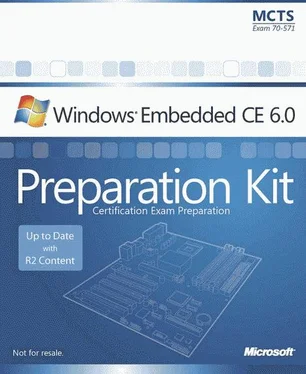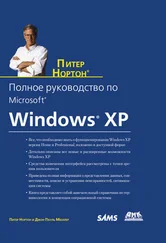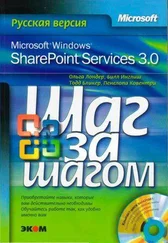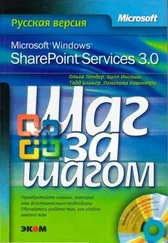Nicolas Besson - Microsoft Windows Embedded CE 6.0 Exam Preparation Kit
Здесь есть возможность читать онлайн «Nicolas Besson - Microsoft Windows Embedded CE 6.0 Exam Preparation Kit» весь текст электронной книги совершенно бесплатно (целиком полную версию без сокращений). В некоторых случаях можно слушать аудио, скачать через торрент в формате fb2 и присутствует краткое содержание. Город: Redmond, Год выпуска: 2008, Издательство: Microsoft, Жанр: Руководства, ОС и Сети, Программы, на английском языке. Описание произведения, (предисловие) а так же отзывы посетителей доступны на портале библиотеки ЛибКат.
- Название:Microsoft Windows Embedded CE 6.0 Exam Preparation Kit
- Автор:
- Издательство:Microsoft
- Жанр:
- Год:2008
- Город:Redmond
- ISBN:нет данных
- Рейтинг книги:5 / 5. Голосов: 1
-
Избранное:Добавить в избранное
- Отзывы:
-
Ваша оценка:
- 100
- 1
- 2
- 3
- 4
- 5
Microsoft Windows Embedded CE 6.0 Exam Preparation Kit: краткое содержание, описание и аннотация
Предлагаем к чтению аннотацию, описание, краткое содержание или предисловие (зависит от того, что написал сам автор книги «Microsoft Windows Embedded CE 6.0 Exam Preparation Kit»). Если вы не нашли необходимую информацию о книге — напишите в комментариях, мы постараемся отыскать её.
Microsoft Windows Embedded CE 6.0 Exam Preparation Kit — читать онлайн бесплатно полную книгу (весь текст) целиком
Ниже представлен текст книги, разбитый по страницам. Система сохранения места последней прочитанной страницы, позволяет с удобством читать онлайн бесплатно книгу «Microsoft Windows Embedded CE 6.0 Exam Preparation Kit», без необходимости каждый раз заново искать на чём Вы остановились. Поставьте закладку, и сможете в любой момент перейти на страницу, на которой закончили чтение.
Интервал:
Закладка:
Located at the core of the operating system, the OAL is a perfect choice for mechanisms to measure the performance of the system and support performance optimization. As discussed in Chapter 3, "Performing System Programming," you can use the Interrupt Latency Timing (ILTiming) tool to measure the time it takes to invoke an interrupt service routine (ISR) after an interrupt occurred (ISR latency) and the time between when the ISR exits and the interrupt service thread (IST) actually starts (IST latency). However, this tool requires a system hardware tick timer or alternative high-resolution timer that is not available on all hardware platforms. If the new hardware platform supports a high-resolution hardware timer, you can support ILTiming and similar tools by implementing the functions listed in Table 5-7.<\/p>
Table 5-7 Profile timer support functions<\/strong> <\/p>
| Function<\/th> | Description<\/th> <\/tr> | ||||||||
|---|---|---|---|---|---|---|---|---|---|
| OEMProfileTimerEnable<\/td> | Enables a profiler timer.<\/td> <\/tr> | ||||||||
| OEMProfileTimerDisable<\/td> | Disables a profiler timer.<\/td> <\/tr> <\/table>
NOTE<\/div>
Thread scheduling and interrupt handling<\/div>
The OAL must also support interrupt handling and the kernel scheduler. The scheduler is independent of the processor type, yet interrupt handling must be optimized for different types of processors.<\/p> <\/cite> Integrating New Device Drivers<\/p> <\/div> Apart from the core system functions, the BSP also contains device drivers for peripherals. These peripheral devices can be components on the processor chip or external components. Even when separate from the processor, they remain an integral part of the hardware platform.<\/p> Device Driver Code Locations<\/p> <\/div> Table 5-8 lists the source code locations for device drivers according to the PQOAL model. If your BSP is based on the same processor as the reference BSP, then the adaptation of device drivers mainly requires modification to the source code in the %TGTPLATROOT% folder. It is also possible to add new drivers to the BSP if the new platform includes peripherals that are not present in the reference platform. For more information about developing device drivers, see Chapter 6, "Developing Device Drivers."<\/p> Table 5-8 Source code folders for device drivers<\/strong> <\/p>
|
Интервал:
Закладка:
Похожие книги на «Microsoft Windows Embedded CE 6.0 Exam Preparation Kit»
Представляем Вашему вниманию похожие книги на «Microsoft Windows Embedded CE 6.0 Exam Preparation Kit» списком для выбора. Мы отобрали схожую по названию и смыслу литературу в надежде предоставить читателям больше вариантов отыскать новые, интересные, ещё непрочитанные произведения.
Обсуждение, отзывы о книге «Microsoft Windows Embedded CE 6.0 Exam Preparation Kit» и просто собственные мнения читателей. Оставьте ваши комментарии, напишите, что Вы думаете о произведении, его смысле или главных героях. Укажите что конкретно понравилось, а что нет, и почему Вы так считаете.








